 W
WCharadrius is a genus of plovers, a group of wading birds. The genus name Charadrius is a Late Latin word for a yellowish bird mentioned in the fourth-century Vulgate. They are found throughout the world.
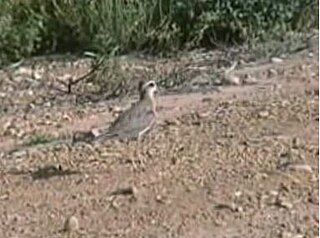 W
WThe Caspian plover is a wader in the plover family of birds. The genus name Charadrius is a Late Latin word for a yellowish bird mentioned in the fourth-century Vulgate. It derives from Ancient Greek kharadrios a bird found in ravines and river valleys. The specific asiaticus is Latin and means "Asian", although in binomials it usually means the type locality was India.
 W
WThe chestnut-banded plover is a species of bird in the family Charadriidae. This species has a large range, being distributed across Southern Africa. However, it occupies a rather small area.
 W
WThe collared plover is a small shorebird in the plover family, Charadriidae. It lives along coasts and riverbanks of the tropical to temperate Americas, from central Mexico south to Chile and Argentina.
 W
WThe common ringed plover or ringed plover is a small plover that breeds in Arctic Eurasia. The genus name Charadrius is a Late Latin word for a yellowish bird mentioned in the fourth-century Vulgate. It derives from Ancient Greek kharadrios a bird found in ravines and river valleys. The specific hiaticula is Latin and has a similar meaning to the Greek term, coming from hiatus, "cleft" and -cola, "dweller".
 W
WThe double-banded plover, known as the banded dotterel or pohowera in New Zealand, is a species of bird in the plover family. Two subspecies are recognised: the nominate Charadrius bicinctus bicinctus, which breeds throughout New Zealand, including the Chatham Islands, and Charadrius bicinctus exilis, which breeds in New Zealand's subantarctic Auckland Islands.
 W
WThe Eurasian dotterel, also known in Europe as just dotterel, is a small wader in the plover family of birds.
 W
WForbes's plover or Forbes's banded plover, is a small wader. This plover is resident in much of west Africa, mainly on inland rivers, pools and lakes. Its nest is a scrape lined with small pebbles in rocky uplands. After breeding in the wet season, this bird moves to open grasslands, including airfields and golf courses, in the dry season. It is sometimes seen at pools or reservoirs.
 W
WThe greater sand plover is a small wader in the plover family of birds. The spelling is commonly given as "greater sandplover" or "greater sand-plover", but the official British Ornithologists' Union spelling is "Greater Sand Plover". The genus name Charadrius is a Late Latin word for a yellowish bird mentioned in the fourth-century Vulgate. It derives from Ancient Greek kharadrios a bird found in ravines and river valleys. The specific leschenaultii commemorates the French botanist Jean Baptiste Leschenault de la Tour.
 W
WThe Javan plover is a bird species in the family Charadriidae. It is endemic to Indonesia, where it inhabits sandy shores and intertidal mudflats. It is threatened by habitat loss but is listed as Least concern on the IUCN Red List.
 W
WThe Kentish plover is a small cosmopolitan shorebird of the family Charadriidae that breeds on the shores of saline lakes, lagoons, and coasts, populating sand dunes, marshes, semi-arid desert, and tundra. Both male and female birds have pale plumages with a white underside, grey/brown back, dark legs and a dark bill, however additionally the male birds also exhibit very dark incomplete breast bands, and dark markings either side of their head, therefore the Kentish plover is regarded as sexually dimorphic
 W
WThe killdeer is a large plover found in the Americas. It was described and given its current scientific name in 1758 by Carl Linnaeus in the 10th edition of his Systema Naturae. Three subspecies are described. The killdeer's common name comes from its often-heard call. Its upperparts are mostly brown with rufous fringes, the head has patches of white and black, and two black bands cross the breast. The belly and the rest of the breast are white. The nominate subspecies breeds from southeastern Alaska and southern Canada to Mexico. It is seen year-round in the southern half of its breeding range; the subspecies C. v. ternominatus is probably resident in the West Indies, and C. v. peruvianus inhabits Peru and areas of the surrounding countries throughout the year. North American breeders winter from their resident range south to Central America, the West Indies, and the northernmost portions of South America.
 W
WKittlitz's plover is a small shorebird in the family Charadriidae that breeds near coastal and inland saltmarshes, sandy or muddy riverbanks or alkaline grasslands with short vegetation. It is native to much of Sub-Saharan Africa, the Nile Delta and Madagascar. It is thought to be mainly monogamous and has monomorphic plumage.
 W
WThe lesser sand plover is a small wader in the plover family of birds. The spelling is commonly given as lesser sand-plover, but the official British Ornithologists' Union spelling is "lesser sand plover". The genus name Charadrius is a Late Latin word for a yellowish bird mentioned in the fourth-century Vulgate. It derives from Ancient Greek kharadrios a bird found in ravines and river valleys. The specific mongolus is Latin and refers to Mongolia which at the time of naming referred to a larger area than the present country.
 W
WThe little ringed plover is a small plover. The genus name Charadrius is a Late Latin word for a yellowish bird mentioned in the fourth-century Vulgate. It derives from Ancient Greek kharadrios a bird found in river valleys. The specific dubius is Latin for doubtful, since Sonnerat, writing in 1776, thought this bird might be just a variant of common ringed plover.
 W
WThe long-billed plover is a species of wading bird in the family Charadriidae. It can be found in Bangladesh, Bhutan, Brunei, Cambodia, China, Hong Kong, India, Indonesia, Japan, Laos, Malaysia, Mongolia, Myanmar, Nepal, North Korea, Russia, South Korea, Sri Lanka, Taiwan, Thailand, and Vietnam. The long-billed plover is a migratory bird, so it breeds and spends the winter in different parts of its range. This bird can often be spotted along the shores of rivers, streams, in wetlands, and rice fields. It forages on the shoreline primarily for aquatic insects, insect larvae, and other invertebrates. It is difficult to distinguish between male and female individuals because of their similar plumage. The breeding season starts at the end of February or early March and ends in July. A male and a female forms a monogamous pair and maintains their territory throughout the breeding season. A global population survey in 2016 assessed the long-billed plover as a species of least concern on the International Union for Conservation of Nature (IUCN) Red List.
 W
WThe Madagascar plover, also known as the black-banded plover, is a small monogamous shorebird in the family Charadriidae, native to western Madagascar. It inhabits shores of lagoons, coastal grasslands, and breeds in salt marshes. These plovers mainly nest in open grassland and dry mudflats surrounding alkaline lakes. The species is classified as vulnerable by the IUCN because of its low breeding success, slow reproductive rate, and weak adaptation to increasing habitat loss, leading to declining population numbers.
 W
WThe Malaysian plover is a small wader that nests on beaches and salt flats in Southeast Asia.
 W
WThe mountain plover is a medium-sized ground bird in the plover family (Charadriidae). It is misnamed, as it lives on level land. Unlike most plovers, it is usually not found near bodies of water or even on wet soil; it prefers dry habitat with short grass and bare ground.
 W
WThe New Zealand dotterel is a species of shorebird found only in certain areas of New Zealand. It is also called the New Zealand plover or red-breasted dotterel, and its Māori names include tūturiwhatu, pukunui, and kūkuruatu.
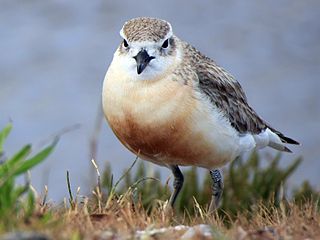 W
WThe northern New Zealand dotterel or northern red-breasted plover is a shorebird which breeds exclusively on beaches in New Zealand's North Island.
 W
WThe oriental plover, also known as the oriental dotterel, is a medium-sized plover closely related to the Caspian plover. It breeds in parts of Mongolia and China, migrating southwards each year to spend its non-breeding season in Indonesia, New Guinea and northern Australia.
 W
WThe piping plover is a small sand-colored, sparrow-sized shorebird that nests and feeds along coastal sand and gravel beaches in North America. The adult has yellow-orange-red legs, a black band across the forehead from eye to eye, and a black stripe running along the breast line. This chest band is usually thicker in males during the breeding season, and it is the only reliable way to tell the sexes apart. The bird is difficult to see when it is standing still, as it blends well with open, sandy beach habitats. It typically runs in short, quick spurts and then stops.
 W
WThe puna plover is a species of bird of the genus Charadrius and the family Charadriidae. It is found in Argentina, Bolivia, Chile, and Peru. Its natural habitats include permanent freshwater lakes as well as saline, brackish, and alkaline marshes. The IUCN Red List assessed the puna plover as "least concern" on October 1st, 2016.
 W
WThe red-capped plover, also known as the red-capped dotterel, is a small species of plover.
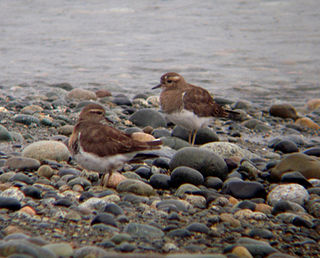 W
WThe rufous-chested plover or rufous-chested dotterel, is a monotypic species of bird measuring 19-22 centimeters in length and weighing between 71 and 94 grams It is part of the family Charadriidae. It breeds in southern parts of Argentina and Chile and on the Falkland Islands. Some birds migrate north in winter, reaching as far as Uruguay, southern Brazil and occasionally Peru. Its natural habitats are temperate grassland and sandy shores.
 W
WThe Saint Helena plover, locally known as the wirebird due to its thin legs, is a small wader endemic to the island of Saint Helena in the mid-Atlantic. The bird is similar in appearance to the Kittlitz's plover of sub-Saharan Africa, but is rather larger. It is the national bird of St Helena and has been depicted on the country's coins. Populations in general have been declining. Threats include predation by cats, the introduction of the common myna, deforestation, off-road vehicle use, the Saint Helena Airport and a projected windfarm. In 2016, the population had recovered to about 560 mature individuals, from a previous minimum of less than 200 in 2006; consequently, the species was downlisted to Vulnerable from its previous assessment of Critically Endangered.
 W
WThe semipalmated plover is a small plover. The genus name Charadrius is a Late Latin word for a yellowish bird mentioned in the fourth-century Vulgate. It derives from Ancient Greek kharadrios a bird found in ravines and river valleys. The specific semipalmatus is Latin and comes from semi, "half" and palma, "palm". Like the English name, this refers to its only partly webbed feet.
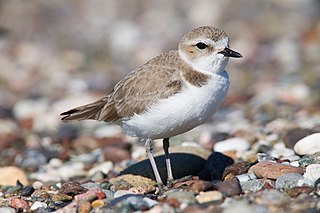 W
WThe snowy plover is a small wader in the plover bird family, typically about 5-7" in length. It breeds in the southern and western United States, the Caribbean, Ecuador, Peru, and Chile. Long considered to be a subspecies of the Kentish plover, it is now known to be a distinct species.
 W
WThe southern red-breasted plover or southern New Zealand dotterel is a bird endemic to New Zealand, and was once widespread across the South Island, though now it breeds nearly exclusively on Stewart Island.
 W
WThe three-banded plover, or three-banded sandplover, is a small wader. This plover is resident in much of eastern and southern Africa and Madagascar, mainly on inland rivers, pools, and lakes. Its nest is a bare scrape on shingle. This species is often seen as single individuals, but it will form small flocks. It hunts by sight for insects, worms and other invertebrates. Three-banded plovers have a sharp whistled weeet-weet call.
 W
WThe two-banded plover is a species of bird in the family Charadriidae. It breeds in Argentina, Chile and the Falkland Islands. Part of the population migrates north in winter with some birds reaching Uruguay and southern Brazil.
 W
WThe western snowy plover is a small wader in the plover bird family. It breeds in the southern and western United States and the Caribbean.
 W
WThe white-faced plover is a small shorebird of the family Charadriidae. Initially described by British ornithologist Robert Swinhoe, the bird resembles the Kentish plover with which it has been much confused and sometimes considered to be a subspecies.
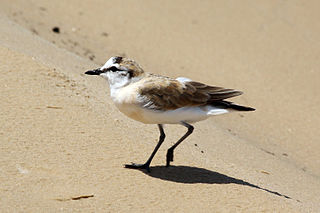 W
WThe white-fronted plover or white-fronted sandplover is a small shorebird of the family Charadriidae that inhabits sandy beaches, dunes, mudflats and the shores of rivers and lakes in sub-saharan Africa and Madagascar. It nests in small shallow scrapes in the ground and lays clutches of 1-3 eggs. The species is monogamous and long-lived, with a life expectancy of approximately 11 years. The vast majority of pairs that mate together stay together during the following years of breeding and retain the same territory. The white-fronted plover has a similar appearance to the Kentish plover, with a white fore crown and dark bands connecting the eyes to the bill.
 W
WWilson's plover is a small bird of the family Charadriidae.